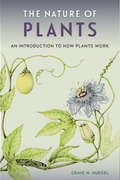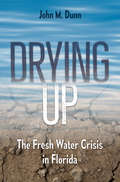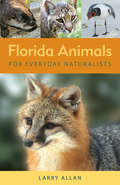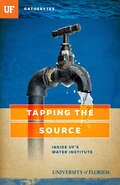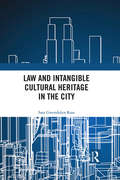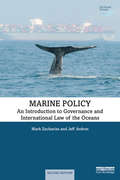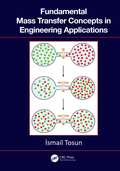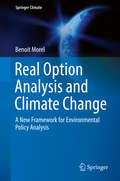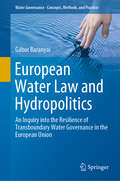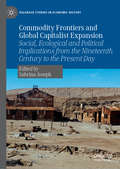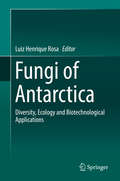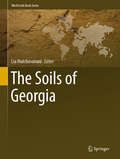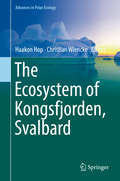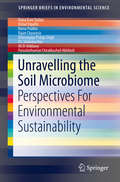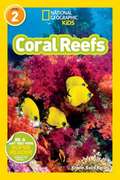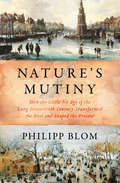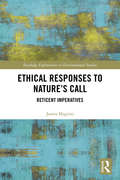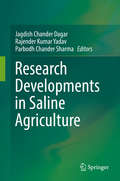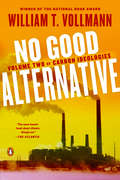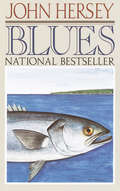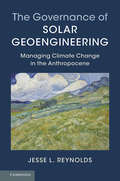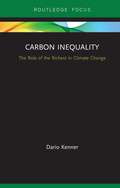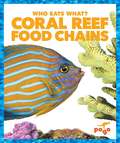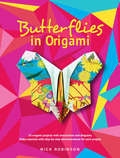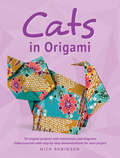- Table View
- List View
The Nature of Plants: An Introduction to How Plants Work
by Craig N. HuegelPlants play a critical role in how we experience our environment. They create calming green spaces, provide oxygen for us to breathe, and nourish our senses. In The Nature of Plants, ecologist and nursery owner Craig Huegel demystifies the complex lives of plants and provides readers with an extensive tour into their workings. Beginning with the importance of light, water, and soil, Huegel describes the process of photosynthesis and how best to position plants to receive optimal sunlight. He explains why plants suffer from overwatering, what essential elements plants need to flourish, and what important soil organisms reside with them. Readers will understand the difference between friendly and hostile bacteria, fungi, and insects. Sections on plant structure and reproduction focus in detail on major plant organs—roots, stems, and leaves—and cover flowering, pollination, fruit development, and seed germination. Huegel even delves into the mysterious world of plant communication, exploring the messages conveyed to animals or other plants through chemical scents and hormones. With color illustrations, photographs, and real-life examples from his own gardening experiences, Huegel equips budding botanists, ecologists, and even the most novice gardeners with knowledge that will help them understand and foster plants of all types.
Drying Up: The Fresh Water Crisis in Florida
by John M. DunnAmerica’s wettest state is running out of water. Florida—with its swamps, lakes, extensive coastlines, and legions of life-giving springs—faces a drinking water crisis. Drying Up is a wake-up call and a hard look at what the future holds for those who call Florida home. Journalist and educator John Dunn untangles the many causes of the state’s freshwater problems. Drainage projects, construction, and urbanization, especially in the fragile wetlands of South Florida, have changed and shrunk natural water systems. Pollution, failing infrastructure, increasing outbreaks of toxic algae blooms, and pharmaceutical contamination are worsening water quality. Climate change, sea level rise, and groundwater pumping are spoiling freshwater resources with saltwater intrusion. Because of shortages, fights have broken out over rights to the Apalachicola River, Lake Okeechobee, the Everglades, and other important watersheds. Many scientists think Florida has already passed the tipping point, Dunn warns. Drawing on more than one hundred interviews and years of research, he affirms that soon there will not be enough water to meet demand if “business as usual” prevails. He investigates previous and current restoration efforts as well as proposed future solutions, including the “soft path for water” approach that uses green infrastructure to mimic natural hydrology. As millions of new residents are expected to arrive in Florida in the coming decades, this book is a timely introduction to a problem that will escalate dramatically—and not just in Florida. Dunn cautions that freshwater scarcity is a worldwide trend that can only be tackled effectively with cooperation and single-minded focus by all stakeholders involved—local and federal government, private enterprise, and citizens. He challenges readers to rethink their relationship with water and adopt a new philosophy that compels them to protect the planet’s most precious resource.
Florida Animals for Everyday Naturalists
by Larry AllanDid you know fawns have no scent, an evolutionary defense against predators? And that the eastern grey squirrel is a formidable swimmer, which makes them quite suited for the Sunshine State? And that, unlike other avians, Florida scrub jay families stay together for years, with older siblings helping to feed younger siblings?Florida Animals for Everyday Naturalists contains everything you want to know about Florida’s furry, feathered, scaled, and shelled friends. With lively personal essays and stunning photographs, Larry Allan introduces you to the array of wildlife you might encounter in your backyard, at the park, or on a jaunt at one of the state’s many wildlife refuges. Each chapter is dedicated to a specific animal, like the bobcat, the river otter, and the caracara, and paired with vivid photos to help you identify these creatures in the wild.Allan’s fascination with Florida fauna is contagious, and his reverence of nature is unmistakable. While sharing his whimsical, enlightening, and instructive anecdotes, he gently argues for wildlife preservation in Florida and for responsible human-animal interactions.Perfect for young naturalists, inquisitive trekkers through the Sunshine State, or armchair adventurers, this book will help you appreciate the abundance of life right outside your door.
Tapping the Source: Inside UF's Water Institute
by Terry Tomalin University of FloridaThe University of Florida has an ambitious goal: to harness the power of its faculty, staff, students, and alumni to solve some of society’s most pressing problems and to become a resource for the state of Florida, the nation, and the world. Florida has 51,858 miles of rivers and streams, more than 2 million acres of lakes and ponds, 11.4 million acres of wetlands, 4,437 square miles of bays and estuaries, and 8,436 miles of coastline. But these water resources face myriad threats. Tapping the Source takes us inside the UF Water Institute, where talent from throughout the university address complex water issues through innovative research, education, and public outreach programs. Interdisciplinary teams from the School of Natural Resources and Environment, the School of Forest Resources and Conservation, Environmental Engineering Sciences, Geological Sciences, Soil and Water Science, and other departments develop new scientific breakthroughs, creative engineering, policy and legal solutions, and pioneering educational programs that are renowned for addressing state, national, and global water-resource problems. The teams work to manage nitrate flows into the north-central Florida springs, evaluating whether reduction of these nitrates alone will be enough to return the springs to their natural state. They assess the impact of pollutants and other stressors on the aquifer and look at historic rainfall averages and the abundance of algae and grazers, like freshwater snails, present in the ecosystem. Ultimately, they attempt to balance the demand for drinking water for a growing population and irrigation water for agriculture with the simultaneous pressures to prevent pollution and leave enough water for natural ecosystem functions. The stories chronicled in Gatorbytes span all colleges and units across the UF campus. They detail the far-reaching impact of UF's research, technologies, and innovations--and the UF faculty members dedicated to them. Gatorbytes describe how UF is continuing to build on its strengths and extend the reach of its efforts so that it can help even more people in even more places.
Law and Intangible Cultural Heritage in the City
by Sara Gwendolyn RossWith disappearing music venues, and arts and culture communities at constant risk of displacement in our urban centers, the preservation of intangible cultural heritage is of growing concern to global cities. This book addresses the role and protection of intangible cultural heritage in the urban context. Using the methodology of Urban Legal Anthropology, the author provides an ethnographic account of the civic effort of Toronto to become a Music City from 2014-18 in the context of redevelopment and gentrification pressures. Through this, the book elucidates the problems cities like Toronto have in equitably protecting intangible cultural heritage and what can be done to address this. It also evaluates the engagement that Toronto and other cities have had with international legal frameworks intended to protect intangible cultural heritage, as well as potential counterhegemonic uses of hegemonic legal tools. Understanding urban intangible cultural heritage and the communities of people who produce it is of importance to a range of actors, from urban developers looking to formulate livable and sustainable neighbourhoods, to city leaders looking for ways in which their city can flourish, to scholars and individuals concerned with equitability and the right to the city. This book is the beginning of a conservation about what is important for us to protect in the city for future generations beyond built structures, and the role of intangible cultural heritage in the creation of full and happy lives. The book is of interest to legal and sociolegal readers, specifically those who study cities, cultural heritage law, and legal anthropology.
Marine Policy: An Introduction to Governance and International Law of the Oceans (Earthscan Oceans)
by Mark Zacharias Jeff ArdronThis book provides readers with a foundation in policy development and analysis, describing how policy, including legal mechanisms, are applied to the marine environment. It presents a systematic treatment of all aspects of marine policy, including climate change, energy, environmental protection, fisheries, mining and transportation. The health of marine environments worldwide is steadily declining, and these trends have been widely reported. Marine Policy summarizes the importance of the ocean governance nexus, discussing current and anticipated challenges facing marine ecosystems, human activities, and efforts to address these threats. This new, fully revised edition has been updated throughout, including content to reflect the recent advances in ocean management and international law. Chapters on shipping, energy/mining and integrated approaches to ocean management have been significantly reworked, plus completely new chapters on the United Nations Convention on the Law of the Sea, and the impacts of climate change have been added. Pedagogical features for students are included throughout. Aligned with current course offerings, this book is an ideal introduction for undergraduates and graduate students taking marine affairs, science and policy courses.
Fundamental Mass Transfer Concepts in Engineering Applications
by Ismail TosunFundamental Mass Transfer Concepts in Engineering Applications provides the basic principles of mass transfer to upper undergraduate and graduate students from different disciplines. This book outlines foundational material and equips students with sufficient mathematical skills to tackle various engineering problems with confidence. It covers mass transfer in both binary and multicomponent systems and integrates the use of Mathcad® for solving problems. This textbook is an ideal resource for a one-semester course. Key Features The concepts are explained with the utmost clarity in simple and elegant language Presents theory followed by a variety of practical, fully-worked example problems Includes a summary of the mathematics necessary for mass transfer calculations in an appendix Provides ancillary Mathcad® subroutines Includes end-of-chapter problems and a solutions manual for adopting instructors
Real Option Analysis and Climate Change: A New Framework for Environmental Policy Analysis (Springer Climate)
by Benoit MorelThis book sets out to reframe the theory of real options so that it can be used to support environmental investments for climate change adaptation and mitigation. Climate change policy often involves making decisions that concern extended time periods, and doing so under considerable uncertainty. By expanding and broadening the framework of real options, this book first introduces readers to new ways of quantifying investment decisions that can much more effectively address the shape and size of the uncertainty than traditional approaches using Net Present Value. In turn, the second part of the book applies this new theoretical framework to climate change policy by presenting a number of examples, and by providing a general perspective on investment decisions related to climate change and how to prioritize them.
European Water Law and Hydropolitics: An Inquiry into the Resilience of Transboundary Water Governance in the European Union (Water Governance - Concepts, Methods, and Practice)
by Gábor BaranyaiThis book provides the first comprehensive assessment of the various issues faced by countries in the European Union, where progressing climate change and urbanization pose significant cooperative challenges in a large number of river basins. Conducting a thorough analysis of the intricate web of EU water governance, it reveals that the hydropolitical stability of the European Union is already at risk. Further, given the structural nature of the shortcomings in EU water policy—e.g. the rigidity of the EU’s founding treaties or the institutional complacency of the European Commission—the book argues that these risks are likely to turn into sources of prolonged conflict, unless EU decision-making bodies take steps to address the new hydrological realities early on.
Commodity Frontiers and Global Capitalist Expansion: Social, Ecological and Political Implications from the Nineteenth Century to the Present Day (Palgrave Studies in Economic History)
by Sabrina JosephThis interdisciplinary edited collection explores the dynamics of global capitalist expansion through the concept of the ‘commodity frontier’. Applying an inductive approach rather than starting at the global level, as most meta-narratives have done, this book sheds light on how local dynamics have shaped the process of capitalist expansion into ‘uncommodified’ spaces. Contributors demonstrate that ultimately the evolution of frontier zones and their reconfiguration over time have transformed human ecology, labour relations and social, economic and political structures across the globe. Chapters examine agricultural and pastoral frontiers, natural habitats, and commodity frontiers with fossil fuels and mineral resources located in various regions of the world, including South America, Asia, Africa and the Arabian Gulf.
Fungi of Antarctica: Diversity, Ecology and Biotechnological Applications
by Luiz Henrique RosaThis book focuses on the fungi found in one of the most pristine regions on Earth: Antarctica. It discusses the fungal occurrence in all substrates of the region, including soil, seawater, lake and marine sediments, rocks, ice, and snow. It also addresses the impact of climate changes on these organisms, the genomic techniques developed to study them, and how a number of compounds, such as antibiotics and enzymes, produced by the Antarctic fungi can be used in medicine, agriculture and the chemical industry.
The Soils of Georgia (World Soils Book Series)
by Lia MatchavarianiThis book provides an extensive overview of the diversity of soils in Georgia. It highlights the soil-forming environment (climate, geology, geomorphology), the characterization of the physical, chemical and morphological (macro-, micro-) properties of soils, the history of soil research in Georgia, and the geographic distribution of different soil types. In addition to describing the soil cover, the book also zones and classifies the soils. Past and current land use issues, ecological properties and implications of soils, and many other aspects are elaborated on; special attention is paid to anthropogenic soil degradation due to the contamination and erosion of soils in Georgia. This comprehensive and richly illustrated book, which includes a wealth of pictures and soil maps, offers an essential field guide for soil scientists, geographers and researchers in related areas.
The Ecosystem of Kongsfjorden, Svalbard (Advances in Polar Ecology #2)
by Haakon Hop Christian WienckeThis book focuses in detail on all ecologically important aspects of the Kongsfjorden system such as the marine and atmospheric environment including long-term monitoring, Ecophysiology of individual species, structure and function of the ecosystem, ecological processes and biological communities.The contributed articles include review articles and research articles that have a wider approach and bring the current research up-to-date. This book will form a baseline for future work.
Unravelling the Soil Microbiome: Perspectives For Environmental Sustainability (SpringerBriefs in Environmental Science)
by Rama Kant Dubey Vishal Tripathi Ratna Prabha Rajan Chaurasia Dhananjaya Pratap Singh Ch. Srinivasa Rao Ali El-Keblawy Purushothaman Chirakkuzhyil AbhilashThis book explores the significance of soil microbial diversity to understand its utility in soil functions, ecosystem services, environmental sustainability, and achieving the sustainable development goals. With a focus on agriculture and environment, the book highlights the importance of the microbial world by providing state-of-the-art technologies for examining the structural and functional attributes of soil microbial diversity for applications in healthcare, industrial biotechnology, and bioremediation studies. In seven chapters, the book will act as a primer for students, environmental biotechnologists, microbial ecologists, plant scientists, and agricultural microbiologists. Chapter 1 introduces readers to the soil microbiome, and chapter 2 discusses the below ground microbial world. Chapter 3 addresses various methods for exploring microbial diversity, chapter 4 discusses the genomics methods, chapter 5 provides the metaproteomics and metatranscriptomics approaches and chapter 6 details the bioinformatics tools for soil microbial community analysis, and chapter 7 concludes the text with future perspectives on further soil microbial uses and applications.
National Geographic Readers: Coral Reefs (Readers Series)
by Kristin RattiniIn this level 2 reader, young readers explore the amazing underwater world of coral reefs. Beautiful photos and carefully leveled text make this book perfect for reading aloud and for independent reading.
Nature's Mutiny: How The Little Ice Age Of The Long Seventeenth Century Transformed The West And Shaped The Present
by Philipp BlomAn illuminating work of environmental history that chronicles the great climate crisis of the 1600s, which transformed the social and political fabric of Europe. <P><P> Although hints of a crisis appeared as early as the 1570s, the temperature by the end of the sixteenth century plummeted so drastically that Mediterranean harbors were covered with ice, birds literally dropped out of the sky, and “frost fairs” were erected on a frozen Thames—with kiosks, taverns, and even brothels that become a semi-permanent part of the city. <P><P> Recounting the deep legacy and far-ranging consequences of this “Little Ice Age,” acclaimed historian Philipp Blom reveals how the European landscape had suddenly, but ineradicably, changed by the mid-seventeenth century. While apocalyptic weather patterns destroyed entire harvests and incited mass migrations, they gave rise to the growth of European cities, the emergence of early capitalism, and the vigorous stirrings of the Enlightenment. A timely examination of how a society responds to profound and unexpected change, Nature’s Mutiny will transform the way we think about climate change in the twenty-first century and beyond.
Ethical Responses to Nature’s Call: Reticent Imperatives (Routledge Explorations in Environmental Studies)
by James MagriniArguing for a renewed view of objects and nature, Ethical Responses to Nature’s Call considers how it is possible to understand our ethical duties - in the form of ethical intuitionalism - to nature and the planet by listening to and releasing ourselves over to the call or address of nature. Blending several strands of philosophical thought, such as Graham Harman’s Object-Oriented Ontology, W. D. Ross’s prima fathics, Alphonso Lingis’s phenomenological ethics traceable to The Imperative, and Michael Bonnett’s ecophilosophy, this book offers a unique rejoinder to the problems and issues that continue to haunt humans’ relationship to nature. The origins of such problems and issues largely remain obscured from view due to the oppressive influence of the "Cultural Framework" which gives form and structure to the ways we understand, discourse on, and comport ourselves in relation to the natural world. Through understanding this "Cultural Framework" we also come to know the responses we continue to offer in answer to nature’s call and address, and are then in a position to analyze and assess those responses in terms of their potential ethical weight. Such a phenomenon is made possible through the descriptive-and-interpretive method of eco-phenomenology. This renewed vision of the human-and-nature provides direction for our interaction with and behavior toward nature in such a way that the ethical insight offers a diagnosis and provides a potentially compelling prescriptive for environmental ills.
Research Developments in Saline Agriculture
by Jagdish Chander Dagar Rajender Kumar Yadav Parbodh Chander SharmaSoil and water salinity is a major challenge for the agricultural community and policy makers in terms of meeting the burgeoning population’s demand for food and other agricultural commodities. In coastal regions, climate change and sea level rise will aggravate the problem with more and more areas becoming saline due to intrusion of sea water. As such there is a pressing need for modern tools and innovative techniques for the identification of salty soils and poor-quality waters, crop production, soil reclamation and lowering the water table in waterlogged areas. Tackling next-generation problems such as contamination of soil and underground water due to fluoride and arsenic, as well as developing multi-stress tolerant crops is also a high priority. Further, techniques for domesticating halophytes, mangrove-based aquacultures, using seaweed cultures as agricultural crops and integrated farming systems need to be perfected. This book addresses all these aspects in detail, highlighting the diverse solutions to tackle the complex problem of salinity and waterlogging and safer management of poor-quality waters. With chapters written by leading experts, it is a valuable resource for researchers planning future investigations, policy makers, farmers and other stakeholders, and for students wanting insights into vital issues of environment.
No Good Alternative: Volume Two of Carbon Ideologies
by William T. VollmannAn eye-opening look at the consequences of coal mining and oil and natural gas production--the second of a two volume work by award-winning author William T. Vollmann on the ideologies of energy production and the causes of climate changeThe second volume of William T. Vollmann's epic book about the factors and human actions that have led to global warming begins in the coal fields of West Virginia and Eastern Kentucky, where "America's best friend" is not merely a fuel, but a "heritage." Over the course of four years Vollmann finds hollowed out towns with coal-polluted streams and acidified drinking water; makes covert visits to mountaintop removal mines; and offers documented accounts of unpaid fines for federal health and safety violations and of miners who died because their bosses cut corners to make more money.To write about natural gas, Vollmann journeys to Greeley, Colorado, where he interviews anti-fracking activists, a city planner, and a homeowner with serious health issues from fracking. Turning to oil production, he speaks with, among others, the former CEO of Conoco and a vice president of the Bank of Oklahoma in charge of energy loans, and conducts furtive roadside interviews of guest workers performing oil-related contract labor in the United Arab Emirates.As with its predecessor, No Immediate Danger, this volume seeks to understand and listen, not to lay blame--except in a few corporate and political cases where outrage is clearly due. Vollmann is a carbon burner just like the rest of us; he describes and quantifies his own power use, then looks around him, trying to explain to the future why it was that we went against scientific consensus, continually increasing the demand for electric power and insisting that we had no good alternative.
Blues
by John HerseyFrom the revered Pulitzer Prize winning journalist and writer, comes his National Bestseller on one of the world’s oldest and most popular activities, fishing. Presented in narrative form as a conversation between a Fisherman and the Stranger, Hersey draws upon his own experiences and passion as the fisherman reflects on the age old sport, offering his own insights and thoughts. From the depths of the ocean to the creatures near the shore, Hersey perfectly answers why fishing has been such an integral part of humanity. “Almost no one has answered “why fish?” better than Mr. Hersey . . . what he does best of all is evoke wonder.”—New York Times Book Review“Blues is, of course, about much more than the pleasures and techniqu3es of fishing; it is, as Fisherman tells Stranger, about interconnections—the ties between mankind and the natural world, among others.”—The New Yorker“Wonderful . . . He gives us a rich and vivid sense of ocean life. . . . The whole thing is as stately as a minuet, and as graceful.”—Chicago Sun-Times
The Governance of Solar Geoengineering: Managing Climate Change in the Anthropocene
by Jesse L. ReynoldsClimate change is among the world's most important problems, and solutions based on emission cuts or adapting to new climates remain elusive. One set of proposals receiving increasing attention among scientists and policymakers is 'solar geoengineering', (also known as solar radiation modification) which would reflect a small portion of incoming sunlight to reduce climate change. Evidence indicates that this could be effective, inexpensive, and technically feasible, but it poses environmental risks and social challenges. Governance will thus be crucial. In The Governance of Solar Geoengineering, Jesse L. Reynolds draws on law, political science, and economics to show how solar geoengineering is, could, and should be governed. The book considers states' incentives and behavior, international and national law, intellectual property, compensation for possible harm, and non-state governance. It also recommends how solar geoengineering could be responsibly researched, developed, and - if appropriate - used in ways that would improve human well-being and ensure sustainability.
Carbon Inequality: The Role of the Richest in Climate Change (Routledge Focus on Environment and Sustainability)
by Dario KennerWith a specific focus on the United States and the United Kingdom, Carbon Inequality studies the role of the richest people in contributing to climate change via their luxury consumption and their investments. In an innovative contribution, it attempts to quantify personal responsibility for shareholdings in large fossil fuel companies. This book explores the implications of the richest people’s historic responsibility for global warming, the impacts of which affect them less than most others in global society. Kenner analyses how the richest people running large oil and gas companies have successfully used their political influence to lobby the US and UK government. This assessment of their growing political power is particularly pertinent at a time of increasing inequality and growing public awareness of the impact of climate change. The book also highlights the crucial role of the richest in blocking the low-carbon transition in the US and the UK, exploring how this could be countered to ensure fossil fuels are fully replaced by renewable energy. This book will be of great relevance to scholars and policy makers with an interest in inequality, climate change and sustainability transitions.
Coral Reef Food Chains (Who Eats What?)
by R. J. BaileyIn Coral Reef Food Chains, early fluent readers explore the coral reef biome and the food chains it supports. Vibrant, full-color photos and carefully leveled text engage young readers as they explore how energy flows through plants and animals on a coral reef.
Butterflies in Origami
by Nick RobinsonOrigami master Nick Robinson presents 20 delightful butterfly models for folders at every level of experience. In this easy-to-follow guide, he offers fold-by-fold instructions that are fully illustrated with color photos and diagrams.Models include such real-life species as the Maniola jurtina, or meadow brown. You'll also find a butterfly bursting from its cocoon, a caterpillar, an envelope with a butterfly, and other imaginative possibilities. Each project is graded according to difficulty.
Cats in Origami
by Nick RobinsonTwenty projects feature cats in various poses, from a grinning Cheshire cat to walking and sleepy felines. Includes step-by-step instructions, illustrated with color photos and diagrams.
